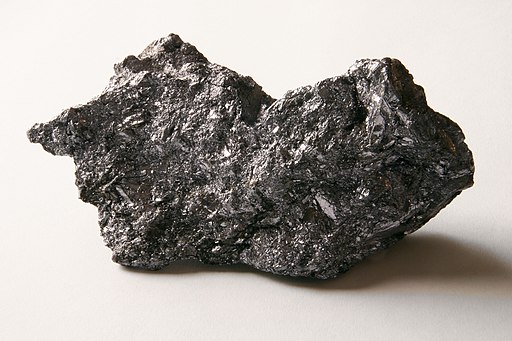
By Steve Voynick
Minerals and mines can have interesting ways of figuring into history. Consider the Knaben mines of southern Norway that were once the world’s leading source of molybdenite, the only ore of molybdenum. As an alloying metal that toughens steel, molybdenum’s military importance during World War II was so great that the Knaben mines became a high-priority Allied bombing target in German-occupied Norway.
Molybdenite (molybdenum disulfide, MoS2) crystallizes in the hexagonal system as opaque, distorted, hexagonal tabs and dark-bluish-gray masses with a metallic luster and a greasy feel. Molybdenite most often occurs as veins and pockets of isolated crystals, disseminated particles, and foliated masses in granitic rocks.
History of ‘Pencil Rock’
The Norwegian peasants who discovered molybdenite outcrops at Knaben in the early 1880s called the mineral “pencil rock” because of the dark, greasy streaks it left on hands and paper. Using the molybdenite as a graphite-like lubricant and stove polish, the Norwegians established its first commercial valuation, initially trading a pound of molybdenite for a pound of butter.
After a small mine opened at Knaben in 1885, molybdenite ore began reaching France and Germany where metallurgists were investigating molybdenum, a silvery-gray metal almost as dense as lead, but much rarer. Molybdenum has an extremely high melting point of 4,730° F. (2610° C.) and, most importantly, an ability to greatly enhance the toughness, durability, and heat- and corrosion-resistance of steel alloys.
German metallurgists were particularly interested in molybdenum and quietly began stockpiling Knaben molybdenite. Amid growing molybdenite demand, two new mines opened at Knaben in 1895.

Germany, France, England Vie For Molybdenite
Molybdenum and the Knaben mines then faded from attention until World War I erupted in 1914 and Germany unexpectedly revealed an arsenal of superior weaponry and armor—much manufactured from tough molybdenum-steel alloys. As competitive bidding between Germany, France, and England drove the price of molybdenite to $5 per pound, the two existing Knaben mines earned huge profits while four more began development.
Despite its low grade—only about 0.2 percent molybdenite—Knaben ore was as valuable as gold ore, grading more than one troy ounce of gold per ton. Occasionally, Knaben miners encountered bonanza pockets, including one found in 1914 that contained a nine-ton mass of 90-percent-pure molybdenite worth $80,000—a small fortune at the time. Knaben’s prosperity as Europe’s primary source of molybdenite was brief, however. Its mines closed when molybdenum prices collapsed after the war.
But with another World War looming in the late 1930s and molybdenum prices soaring, the Knaben mines reopened. This time Germany, with molybdenum vital to its armaments industries, took no chances.
One of its reasons for occupying Norway in 1940 was to control the Knaben mines, both to assure its own supply of molybdenum and to deny it to the Allies.
Competitive Side of Molybdenum Mining
As German miners took charge of production, Germany stationed 1,000 troops at Knaben and constructed a formidable ring of antiaircraft batteries. Several Allied bombing efforts—including one of 30 heavy bombers—failed to stop production and Knaben remained Germany’s primary source of molybdenum for the duration of the war.
During the post-war years, new sources of molybdenite were found in North and South America, Australia, and China. As molybdenite prices and its ore reserves declined so, too, did Knaben’s importance. Its mines finally closed in 1973 and were forgotten for nearly three decades until the area was developed for recreational skiing.
Fortunately, Knaben’s mining heritage is still alive and well. The surviving mill buildings, some dating to World War II, were converted into a mining museum that is also the starting point for an underground tour.
Specimens of Knaben molybdenite—platy, silvery-gray, hexagonal crystals with a distinctive greasy feel and metallic luster—are still occasionally available.
They are both an interesting collectible and, no less importantly, a reminder of the times when a remote Norwegian mine played a critical role in metallurgical research and wartime manufacturing.













